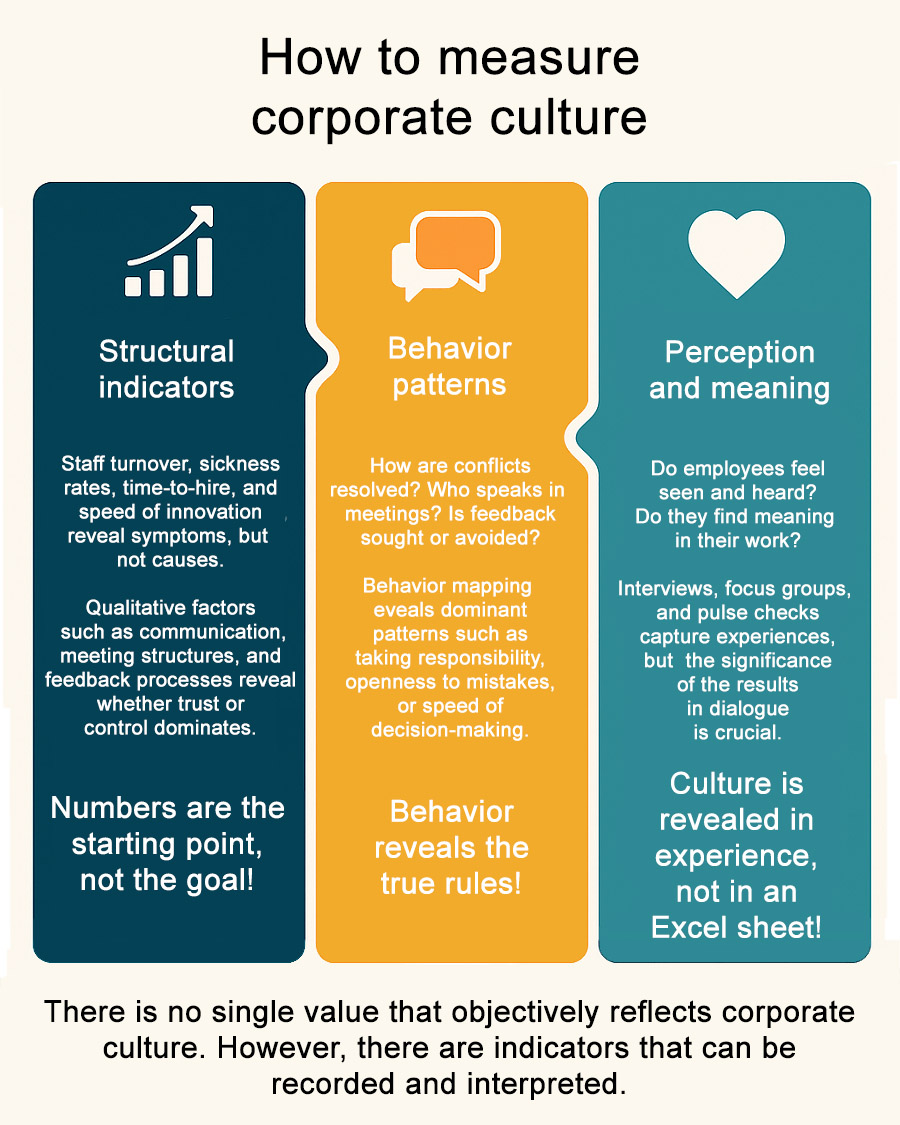How to measure corporate culture …
Expand the table of contents
… and why figures alone are meaningless
‘Culture cannot be measured.’ I hear this phrase time and time again in my work, usually accompanied by a shrug, as if corporate culture were something vague that can be felt but not grasped. At the same time, companies invest a lot of time and money in surveys, engagement scans and employer branding measures in order to capture this very culture.
But the real problem rarely lies in a lack of tools, but rather in the question of what we actually want to measure. Culture is not made up of numbers, but of behaviour. And behaviour can be observed, interpreted and changed if you know what to look for.
In times of hybrid collaboration and skills shortages, understanding culture is more important than ever. Because it determines whether people identify with a company in the long term or mentally check out. Those who do not understand corporate culture lose not only talent, but also innovative strength.
What corporate culture is not
Many companies confuse culture with atmosphere or satisfaction. They measure whether employees feel comfortable and conclude that the culture is good. But that’s like measuring the temperature and concluding what the weather is like.
Corporate culture is more than the result of a survey. It is not a feel-good project, a fruit basket, an after-work event, or what is written on the website.
Corporate culture is what happens when no one is looking: how decisions are made, how mistakes are dealt with, and how people talk about others when they are not in the room.
If you want to understand culture, you should be less interested in the values on the wall and more interested in the patterns in everyday life. Corporate culture is reflected in routines, communication and behaviour, not in marketing messages.
Another misconception: culture cannot be ‘installed’. It is not software that you install once and then it runs. It arises from the daily interaction of people, structures and decisions, and is constantly changing.
What corporate culture really is
Corporate culture is the invisible operating system of an organisation. It determines how people work together, communicate and make decisions. You can’t see it directly, but you can feel its effects.
When a team hesitates to take responsibility, it is often not due to a lack of will, but rather a cultural pattern: ‘Better to do nothing wrong than to stand out.’ When conflicts are repeatedly swept under the carpet, it is not a coincidence, but rather an expression of a culture that values harmony over honesty.
These patterns are the real measuring point. Because culture manifests itself in behaviour, and behaviour can be observed. Culture is therefore not what companies say about themselves, but what they do and what they allow.
A strong corporate culture can be recognised by the fact that people are clear about what is desirable and what is undesirable. It provides orientation in times of change and strengthens teams’ ability to act. A weak culture, on the other hand, manifests itself in uncertainty, silo thinking and conflict avoidance.
Signs of corporate culture
There is no single value that objectively reflects corporate culture. But there are signs that can be recorded and interpreted when viewed in the right context. In my work with organisations, a three-step approach has proven successful:
Structural indicators: Staff turnover, sickness rates, time-to-hire, onboarding success and speed of innovation all provide clues, but not causes. Figures are the starting point, not the goal. Qualitative indicators such as internal communication, meeting structures and feedback processes can also be considered. They show whether structures tend to promote trust or control.
Behavioural patterns: How are conflicts addressed? Who speaks in meetings and who doesn’t? Is feedback sought or avoided? This reveals how secure people feel and how open the system actually is. One helpful tool is ‘behaviour mapping’, which documents the behaviours that dominate in teams, such as taking responsibility, openness to mistakes or speed of decision-making. This data provides insight into implicit norms and taboos.
Perception and meaning: Do employees feel seen, heard and taken seriously? This experience can be captured through qualitative interviews, focus groups or pulse checks. However, it is crucial to interpret the results in dialogue, not in an Excel sheet. Culture arises where people find meaning in their work. A high level of identification with the company’s purpose is often a stronger indicator of a healthy culture than any satisfaction metric.
Figure: Recognising and interpreting signs of corporate culture
The biggest mistake: measuring without context
Many organisations measure without first clarifying what for. This results in impressive dashboards, but no change.
Culture measurement is not a control instrument, but a mirror. And this mirror is only useful if you look into it to understand, not to evaluate.
An example: After conducting a measurement, a company found that the factor ‘teamwork’ was rated low. Instead of investigating the causes, team training sessions were organised, but to no effect. The reason: the culture promoted individual silo thinking. Only when this was openly addressed did change begin.
Another example: A start-up used culture measurement as an early warning system. It found that conflicts were not being addressed openly. Accompanying reflection formats changed the culture of communication and productivity increased measurably.
Culture measurement without context produces numbers. Culture measurement with dialogue produces insight, and this insight is the first step towards development.
Corporate culture as a continuous process
Corporate culture is not a project with an end date. It develops over time, through leadership, structures and everyday decisions. Anyone who wants to measure it needs patience and a willingness to see uncomfortable truths.
If a survey shows that there is a lack of trust in leadership, it is not enough to start coaching. Trust is not created through training, but through consistency between words and actions. Cultural work means making leadership tangible.
That is why measuring culture is not an HR project, but a management task. Leadership creates the framework in which corporate culture becomes visible and tangible. This approach pays off in the long term: companies with a consciously designed culture are demonstrably more innovative, resilient and attractive to skilled workers.
Consistency is key to success. Regular measurement allows developments to be identified at an early stage. On the other hand, those who only review corporate culture once risk overlooking changes or combating symptoms instead of understanding causes.
Practical ways to make corporate culture visible
There are several useful ways to make culture visible in companies:
- Culture reviews: Teams regularly reflect on what strengthens or slows them down.
- Observation interviews: Real situations count more than checklists.
- Storytelling: What stories are circulating about success or failure?
- Feedback loops: Results are discussed openly, not hidden.
- Culture walks: Managers talk directly to people, not just about them.
- Leadership pulse checks: Short, recurring mood surveys on trust, clarity and cooperation.
Another approach is cultural dialogues: cross-departmental workshops in which managers and employees reflect on patterns together. This method promotes understanding and strengthens personal responsibility.
Measurement is only the beginning. What happens next is crucial: whether results are translated into concrete measures and whether leadership is prepared to be part of the change process itself.
Conclusion: Corporate culture is measurable, but not in numbers alone
Corporate culture can be measured if you know what you are looking for, not through isolated KPIs, but through the interplay of data, behaviour and dialogue. Numbers show what is happening. Stories show why. Only both together give a complete picture.
Measuring culture is awareness work. It requires courage, openness and reflection. The most important question is not how to measure culture, but what you want to learn from the results and whether you are prepared to make real changes based on them.
A healthy culture is not recognised by charts, but by moments: when people take responsibility, address conflicts or support each other. This is where it becomes clear whether values are lived or merely formulated.
Companies that take measuring culture seriously do more than just collect data. They create clarity and trust and lay the foundation for long-term success. Those who recognise patterns can consciously shape them. Leaders who understand culture lead differently: with attitude, transparency and genuine responsibility.
In the end, one key question remains: how brave are we to really look? Corporate culture is not a state of being, but a reflection of our leadership and collaboration. Perhaps now is the right moment to use this mirror, not for control, but for development.
Notes:
Are you interested in exchanging ideas with Elisabeth Fabian? Then simply write to her on LinkedIn or visit her excellent website.
You can find more articles on corporate culture on the t2informatik blog:
Would you like to discuss the measurement of corporate culture as a multiplier? Then share this article in your network.

Elisabeth Fabian
Elisabeth Fabian is a leadership expert, speaker and founder of Leadership OS. After around eight years in management and consulting roles, she knows how crucial clear structures and a healthy leadership culture are for growth and employee retention.
With her Leadership OS, she helps tech SMEs turn overwhelmed managers into confident leaders who lead with clarity, attitude and trust, thereby developing teams that stay. She firmly believes that good leadership is not a coincidence, but the result of clear structures, honest communication and a lived culture.
In the t2informatik Blog, we publish articles for people in organisations. For these people, we develop and modernise software. Pragmatic. ✔️ Personal. ✔️ Professional. ✔️ Click here to find out more.
